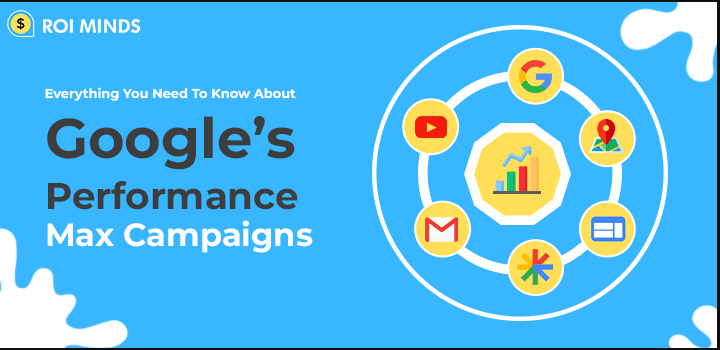Maximize Your ROI :
Performance Max Campaign Strategy Insights
Proven tactics and expert tips to unlock the full potential of Google Ads Performance Max campaigns

Google Ads ⑊ Performance Max Campaign Strategy

- Post by : Absarjoy
- 12:34 am
- August 12, 2025
Driving exceptional ROI with Google’s Performance Max campaigns isn’t about leaving everything to automation — it’s about knowing how to guide it. When powered by the right strategy, PMax can combine Google’s full reach with AI-driven precision to consistently find and convert your most valuable audiences.
As a premier Google Ads agency, we’ve refined this approach through hands-on experience, and in this guide, we’ll share the exact tactics that separate high-performing campaigns from the rest.
Key Takeaways for PMax Success
Leverage Google’s full ecosystem – Performance Max taps into Search, Display, YouTube, Gmail, and Discover simultaneously, using machine learning to place ads where they’ll perform best. High-quality creatives and diverse audience signals are critical to engaging each segment effectively.
Set intentional goals – Define clear conversion objectives to steer the algorithm in the right direction. Feed it rich audience data, refresh your creative assets regularly, and align your bidding strategy with your growth targets.
Optimize with precision – PMax reporting offers deep visibility into performance, from top-of-funnel engagement to final conversions. Refine product feeds, apply negative keywords, and master Final URL Expansion to match ads perfectly with user intent.
Ready to take your digital marketing to the next level? Get started with an initial review of your goals and current program.
Understanding the Mechanics of Performance Max
Performance Max is not just another Google Ads campaign type — it’s a fully integrated, AI-powered system designed to deliver maximum impact across Google’s entire network, including Search, Display, YouTube, Gmail, and Discover. At its core, it uses advanced machine learning to analyze countless data points — from audience behavior and creative performance to bidding efficiency and budget allocation — ensuring your ads appear where they have the greatest potential to convert.
What makes PMax unique is its goal-driven structure. Every campaign is anchored to specific conversion objectives, guiding the creative process and ensuring all messaging aligns with measurable outcomes. This fusion of automation and intent-based targeting allows businesses to scale results without sacrificing precision.
Decoding Performance Max Campaigns
Performance Max (PMax) campaigns expand your Google Ads reach across multiple channels like YouTube, Display, and Gmail—connecting your brand with the right audience beyond traditional search. Powered by advanced machine learning, PMax dynamically optimizes bids and targeting for maximum results.
However, success also relies on a diverse set of high-quality creative assets to engage users effectively across formats. Additionally, strict compliance with Google’s ad policies ensures your campaigns run smoothly without disruption.
Master these fundamentals to unlock the full growth potential of Performance Max campaigns.

The Evolution of Smart Shopping Campaigns
Since their debut in 2021, Performance Max campaigns have significantly evolved, building on the foundation laid by Smart Shopping campaigns. One notable advancement has been the refinement of PMax feed-only campaigns, addressing earlier concerns by preventing automatic budget allocation exclusively to the Shopping network. This shift has allowed advertisers to maintain greater control over budget distribution and reach across Google’s full network.
A standout feature of PMax is the introduction of asset groups — curated sets of creative elements that automatically adapt to the specific channel where the ads appear. This ensures each placement is optimized for both relevance and engagement, maximizing the impact of your campaigns across diverse formats and audiences.
Developing a Successful PMax Strategy
Developing a successful strategy for your Performance Max campaign involves:
- Comprehending PMax’s mechanics
- Aligning your campaign with your product catalog and audience preferences
- Defining clear objectives
- Providing the machine learning algorithm with the best possible inputs
- Setting solid goals for your PMax campaigns
- Ensuring you have a wide variety of creative assets increases the chances of your ad serving across different types of inventory.

Remember, staying proactive is key—regularly adjust your strategy to account for seasonality and product changes. These shifts directly impact PMax’s optimization, so anticipating and adapting to them ensures your campaigns remain ahead of the curve.
Setting Clear Goals for PMax Success
To effectively guide the machine learning in Performance Max campaigns, it’s essential to establish specific conversion goals tailored to each campaign. Clear objectives help maximize ROI and ensure your campaigns focus on desired outcomes—whether through standard goals or custom ones that combine primary and secondary conversions. Defining these goals upfront sets a strong foundation for campaign success.
Patience is key during the machine learning learning phase. Well-defined goals help you navigate early fluctuations and evaluate performance accurately once the system stabilizes.
Audience Signals: Guiding Smart Targeting
Incorporating high-intent audience signals—such as first-party customer data, past purchase behavior, and in-market activity—sharpen targeting precision and boost PMax performance. These signals empower Google’s AI to reach the most valuable users, especially those closer to conversion.
Complementing these with demographic and interest-based data further enhances relevance, creating a personalized experience that resonates with both new prospects and loyal customers alike.
Building High-Impact Asset Groups
Asset groups are the core of Performance Max campaigns, combining images, videos, and text that Google’s AI uses to tailor ads for different audiences. Creating groups based on audience signals improves relevance and boosts conversions.
Regularly updating your creatives keeps ads fresh and expands reach, enhancing overall campaign performance.
Budgeting and Bidding: The PMax Blueprint
The triumph of your PMax campaigns heavily relies on effective budgeting and bidding. Google suggests setting an average daily budget for your PMax campaigns to be at least three times the CPA or cost/conv for the chosen conversion actions. This helps ensure that your campaigns have enough budget to perform effectively. PMax campaigns offer automated bidding strategies like Maximize Conversions and Maximize Conversion Value, which focus on driving conversions while considering cost-efficiency.
As an advertiser, you can start by utilizing Maximize Conversions to accumulate a good amount of conversions before switching focus to Maximize Conversion Value to attract more valuable orders.

Allocating Ad Spend Wisely
Successful Performance Max campaigns require smart budget allocation within your Google Ads account. Google recommends a daily budget of $50–$100 to allow the machine learning algorithm to collect enough data for optimal performance. Campaigns should ideally run for at least six weeks to enable meaningful data gathering and accurate performance evaluation.
If your campaigns generate fewer conversions, it’s better to run fewer campaigns to consolidate data and help the algorithm learn more effectively.
Effective Bidding Strategy
Choosing the right bidding strategy is critical for PMax success. The two main options are Maximize Conversions and Maximize Conversion Value, both aimed at driving results efficiently.
During setup, you can focus your bidding on either conversions or conversion value, and set targets like Cost Per Action (CPA) or Return on Ad Spend (ROAS) for tighter control.
Once sufficient conversion data is collected, you can shift to more advanced bidding strategies like Maximize Conversions with Target CPA or Maximize Conversion Value with Target ROAS, continuously optimizing these to adapt to market changes.
Geo-Targeting for Enhanced Campaign Performance
Geo-targeting is a powerful tool that can significantly improve your Performance Max campaign results. By analyzing location-based performance data—such as
- countries
- states
- ZIP/postal codes
- counties
You can identify where most of your traffic and sales are coming from.
With this insight, you can strategically position your Google Shopping campaigns at different stages of the conversion funnel by adjusting bids and targeting specific geographic areas.
Language Optimization for Global Reach
Language optimization is a crucial component of Performance Max campaigns. By setting language preferences, you ensure your ads reach users in their preferred language, enhancing both user experience and campaign effectiveness. Within PMax, asset groups can be tailored by language to deliver more relevant and understandable ads to each audience segment.Including language-specific creative assets enables precise targeting of multilingual audiences, resulting in more personalized and impactful ad engagements.

PMax Reporting: Insights & Analysis
Performance Max reporting provides valuable insights into campaign performance, top-performing search categories, and audience segments. For deeper analysis, you can create a Performance Max segment in Google Analytics, unlocking detailed reports beyond standard metrics.Full-funnel conversion tracking is essential to accurately evaluate and optimize your campaign’s overall effectiveness.
When comparing PMax results with other campaigns, it’s important to consider overall account performance and be aware of potential attribution overlap. This perspective helps identify inefficiencies and drive optimization across your entire Google Ads account.
Tracking Conversions and Customer Acquisition
Accurate conversion tracking is crucial for optimizing Performance Max campaigns. Misconfigured tracking can lead to incorrect sales data and hinder campaign performance.PMax includes a specific goal for new customer acquisition to help you target growth efficiently.
Advanced conversion tags let you differentiate new versus returning customers, providing clearer insights and enabling measurement of key metrics like customer acquisition cost.
PMax Campaign Optimization Techniques
Optimizing Performance Max campaigns can drive significant performance gains. Key techniques include refining your product feed, using negative keywords strategically, and mastering Final URL Expansion. A well-optimized Google Merchant Center feed ensures Google has all the necessary product data, even when no additional assets are provided.
Final URL Expansion improves relevance by dynamically replacing landing pages based on users’ search queries, boosting campaign effectiveness.
Applying account-level negative keywords helps exclude non-converting placements, reducing wasted spend and sharpening your campaign targeting.

Optimize Product Feed for Peak Performance
Maintaining an accurate and up-to-date product data feed is critical for the success of your Performance Max campaigns. Regular updates ensure your feed reflects current inventory and market demand, directly influencing campaign results and shopping ad delivery.
Key feed optimization tactics include:
Ensuring data accuracy
Refining product titles with Google’s taxonomy
Organizing listing groups to exclude unprofitable products
Using Negative Keywords to Cut Waste
Implementing negative keywords at the account level can significantly improve PMax performance by preventing ads from showing on irrelevant search queries. This saves budget, increases ad relevance, boosts click-through rates, lowers cost per click, and reduces unwanted traffic.
Use insights from traditional search campaigns and keyword themes to identify and exclude non-converting queries effectively.
Controlling Traffic with Final URL Expansion
Final URL Expansion dynamically directs users to the most relevant landing pages based on their search intent. If automatic URL selection doesn’t align with your goals, you can disable this feature in campaign settings.
Maintain control over landing page traffic by using URL exclusions to prevent users from landing on non-commercial pages like blogs, FAQs, or shipping information.
Summary
Performance Max is transforming Google advertising by combining AI-driven automation with multi-channel reach, allowing you to connect with the right audience more efficiently than ever. To maximize ROI, focus on clear goals, rich audience signals, and diverse creative assets. While there are challenges, the benefits—smarter targeting, better optimization, and scalable growth—make it a game-changer.The future of digital marketing is here. It’s time to harness the power of Performance Max and take your campaigns to the next level.

Latest Projects
Stay updated on our best deals in CRO, Analytics, and Advertising
Best Marketing Tools

Andry Brook
Chef Director, Rafel Fashion Ltd, UAE
And once connected to Google Analytics, Meta’s system is then able to use aggregated data from Google to establish more context for your web traffic, which, in combination with the Meta Pixel and the Conversions API, could help to provide more understanding of key performance drivers for your campaigns.And once connected to Google Analytics, Meta’s system is then able to use aggregated data from Google to establish more context for your web traffic, which, in combination with the Meta Pixel and the Conversions API, could help to provide more understanding of key performance drivers for your campaigns.

Anamica Sen
Director Sales
We honestly reference Hostinger as the benchmark for our engineers when providing support. We honestly reference Hostinger as the benchmark for our engineers when providing support.We honestly reference Hostinger as the benchmark for our engineers when providing support.

Synthi Hook
Managing Director, Soft Fashion Ltd, Canada
one place, which was really refreshing.I could manage the hosting, domain name, and SSL certificate in one place, which was really refreshing.I could manage the hosting, domain name, and SSL certificate in one place, which was really refreshing.I could manage the hosting, domain name, and SSL certificate in one place, which was really refreshing.

Testi
Techno, UAE
manage the hosting, domain name, and SSL certificate in one place, which was really refreshing.I could manage the hosting, domain name, and SSL certificate in one place, which was really refreshing.I could manage the hosting, domain name, and SSL certificate in one place, which was really refreshing.

Robert Lee
Techno Manager, United States
I could manage the hosting, domain name, and SSL certificate in one place, which was really refreshing.
Thanks for vising my portfolio !!!

Conversion API setup gives you full control, complete visibility, and reliable performance —without relying on fragile browser-based tracking.
Reach out for tailored Facebook Conversion API setup and expert assistance.
Thanks for vising my blog
Reach out for tailored Performance Max Campaign setup and expert assistance.

